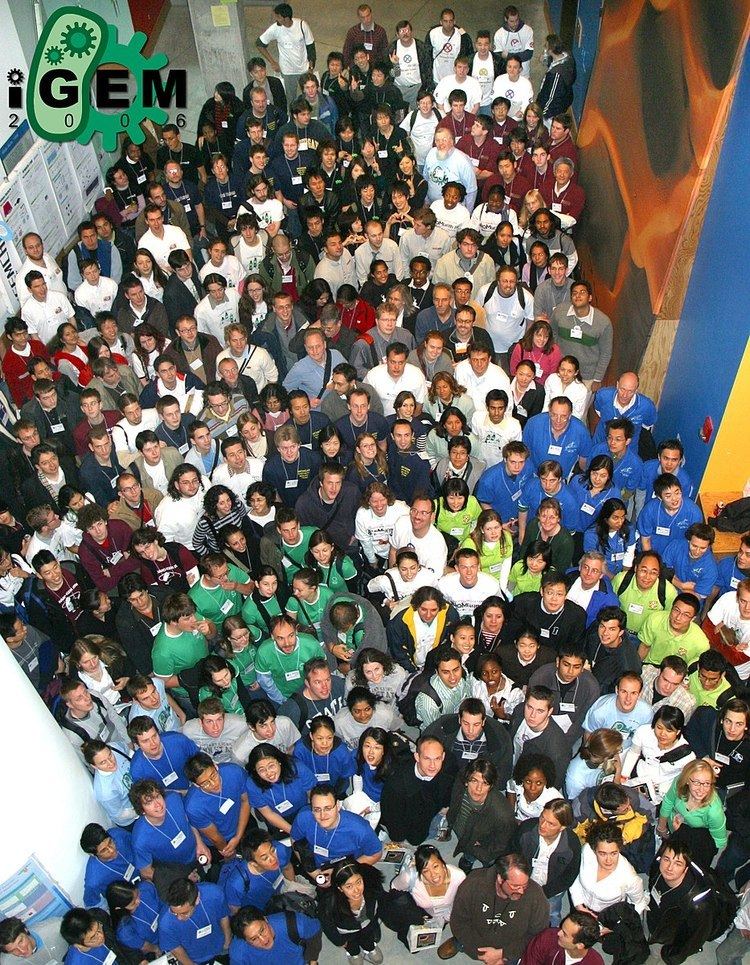Frequency Annually Most recent 2016 | Inaugurated 2003 | |
 | ||
Date(s) October 27 –October 31, 2016 Location(s) Boston, Massachusetts, United States
With additional events worldwide | ||
The International Genetically Engineered Machine (iGEM) competition is a worldwide synthetic biology competition that was initially aimed at undergraduate university students, but has since expanded to include divisions for high school students, entrepreneurs, and community laboratories, as well as 'overgraduates'.
Contents
Competition details
Student teams are given a kit of biological parts at the beginning of the summer from the Registry of Standard Biological Parts consisting of various genetic components such promoters, terminators, reporter elements, and plasmid backbones. Working at their own schools over the summer, they use these parts and new parts of their own design to build biological systems and operate them in living cells. Randy Rettberg, an engineer who has worked for technology companies including Apple, Sun and BBN, is the director of the iGEM competition.
Biological systems / BioBricks
One of the aims of the competition is to attempt to build simple biological systems from standard, interchangeable parts and operate them in living cells.
The iGEM competition facilitates this by providing a library of standardized parts (called BioBrick standard biological parts) to students, and asking them to design and build genetic machines with them. Student teams can also submit their own BioBricks. Successful projects produce cells that exhibit new and unusual properties by engineering sets of multiple genes together with mechanisms to regulate their expression.
Information about BioBrick standard biological parts, and a toolkit to make and manipulate them, is provided by the Registry of Standard Biological Parts, or simply, the Registry. This is a core resource for the iGEM program, and one that has been evolving rapidly to meet the needs of the program.
Broader goals
Beyond just building biological systems, broader goals of iGEM include:
iGEM's dual aspects of self-organization and imaginative manipulation of genetic material have demonstrated a new way to arouse student interest in modern biology and to develop their independent learning skills.
Growth and recent years
iGEM developed out of student projects conducted during MIT's Independent Activities Periods in 2003 and 2004. Later in 2004, a competition with five teams from various schools was held. In 2005, teams from outside the United States took part for the first time. Since then iGEM has continued to grow, with 130 teams entering in 2010.
Because of this increasing size, in the years 2011 - 2013 the competition was split into three regions: Europe, the Americas, and Asia (though teams from Africa and Australia also entered via "Europe" and "Asia" respectively). Regional jamborees occurred during October; and some subset of teams attending those events were selected to advance to the World Championship at MIT in November.
In January 2012 the iGEM Foundation was spun out of MIT as an independent non-profit organization located in Cambridge, Massachusetts, USA. The iGEM Foundation supports scientific research and education through operating the iGEM competition. The same year, iGEM expanded into having not only the Collegiate division, but also competitions for entrepreneurs and high school students.
For their tenth anniversary iGEM added new tracks to the existing ones: Art & Design, Community Labs, Entrepreneurship, Measurement, Microfluidics, Policy & Practice, and Software. Although Entrepreneurship and Software were tracks in previous years, in 2014 they were made more distinct in terms of their judging requirements. Furthermore, in 2014 iGEM did not have regional jamborees, but instead hosted a giant jamboree so every team could participate in one conference in Cambridge unlike in previous years where only the regional finalists were brought to Cambridge.
